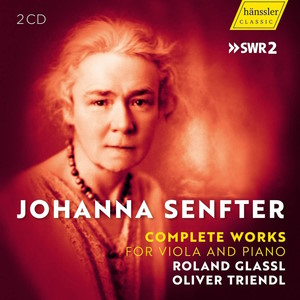
Johanna Senfter (1879-1961)
Complete works for viola and piano
Viola Sonata No.2 in F major, Op.101 (1943)
Viola Sonata No.1 in F minor, Op.41 (1922)
Duo for viola and piano, Op.127 (1956)
Variations for viola and piano, Op.94
Five Pieces for viola and piano, Op.76 (1932)
Roland Glassl (viola)
Oliver Triendl (piano)
rec. 2022, SWR Studio, Kaiserslautern, Germany
HÄNSSLER HC22076 [69 + 55]
To save me from rehashing Johanna Senfter’s biography, I’ll refer you to a review of her violin works from 2019 (review) when some interest in her had already led to a few recordings. Though she studied piano, violin was her major study, along with composition. This last led her from Frankfurt to composing lessons with Reger in Leipzig. He remained something of a pervasive influence on her, harmonically and structurally.
Her works for viola occupy two discs. The Viola Sonata No.1 was composed in 1922 when she into her 40s. It exudes a slightly craggy Regerian element, but she sounds freer in the capricious Scherzo with its warmly textured and lied-like B section. The slow movement is romanticised but not, to me, especially distinguished melodically whilst it’s Brahms who haunts the finale. Here, mid-point, she brings out that most academic of things, a fugato, before it’s back to Brahms.
The Second Sonata followed two decades later in the middle of the war and it’s another big 36-minute work, even longer than the first sonata. The Reger influence is leavened, to a degree, by a fugitive, almost Delian elusiveness in some places though I wouldn’t suggest it’s in any way an impressionist work. Instead, it’s uneasy and introverted but once again finds in the Scherzo a playground of vivacity, wrong-footing rhythmic gamesmanship and a nicely constructed central section. The finale is a well-constructed Theme and Variations. The work is cast in four movements, the notes say, but there are five tracks here, so I am assuming that the tracking is intentional and not a capricious piece of editorialising (I’ve not found a score online, so I am speculating).
The second disc presents a miscellaneous collection, starting with the Duo for viola and piano, written late, just five years before her death. Its threnodic element only partly disguises the freer harmony she uses. The Variations for viola and piano is expressive and melancholic, but at 12 minutes into its 16 minute length once again unveils a fugato which sounds, contextually, unnecessary. This leaves the innocuous-sounding Five Pieces, written in 1932. These are actually quite involved larger-scaled works originally written as a set of six for viola and organ for use in church. They are specifically designed, in original form, for Good Friday, Ascension, the Sunday before Advent, and so on. As a result, these little tone poems are largely cast in reflective, melancholic vein, slow and reverential.
Roland Glassl and Oliver Triendl, one of the world’s most hard-working and ubiquitous pianists, play these works with collegiate assurance, and deft tonal resources, and Hänssler’s recording has been well judged. Jürgen Schaarwächter provides the accomplished notes. I’m not sure, though, that Senfter’s viola works are quite distinctive or novel enough to command real attention.
Jonathan Woolf
Help us financially by purchasing from





















